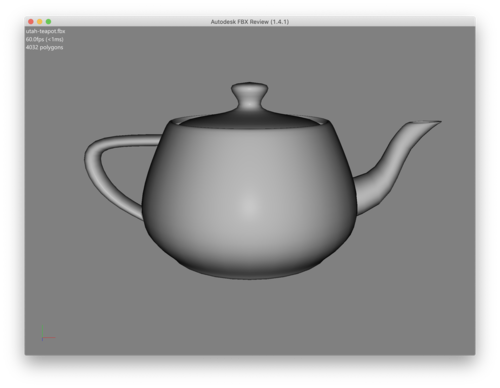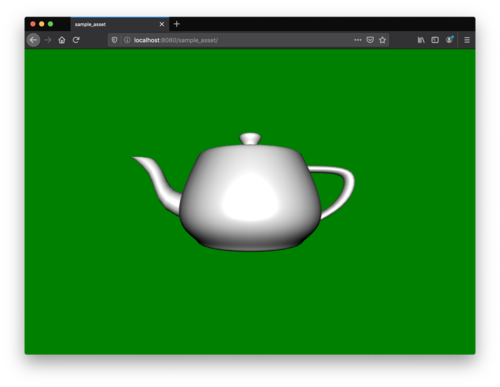Difference between revisions of "Mesh Converter/en"
| Line 156: | Line 156: | ||
cam->setWorldTranslation({0.f, 125.f, -300.f}); | cam->setWorldTranslation({0.f, 125.f, -300.f}); | ||
| − | + | If you assemble the project now, a hand will appear on the screen, but it will not move. | |
Чтобы она задвигалась, нужно запустить аниматор у соответствующего skinned mesh’a. Известно, что skinned mesh у нас один и у него одна анимация, поэтому в цикле пройдем по всему дереву asset’a и всем skinned mesh’ам в нём и будем проигрывать анимацию (в нашем примере - первую): | Чтобы она задвигалась, нужно запустить аниматор у соответствующего skinned mesh’a. Известно, что skinned mesh у нас один и у него одна анимация, поэтому в цикле пройдем по всему дереву asset’a и всем skinned mesh’ам в нём и будем проигрывать анимацию (в нашем примере - первую): | ||
Revision as of 14:25, 19 May 2020
Scope
The W4 game engine uses its own asset storage format. Therefore, before using a third-party asset, it must be converted. You can do this using the Mesh Converter tool that comes with the W4 SDK.
Mesh Converter converts assets from Autodesk FBX (.fbx) format. Other formats are not supported.
Technical limitations
Mesh Converter can convert any fbx with the following restrictions:
1. Due to the hardware and software features of some popular device models, a skinned mesh may contain:
- no more than 28 bones
- no more than 8 vertices per bone
How to use
Downloading the project repository is described in the article Quick Start. The W4MeshConverter.bin file is located in the w4framework/tools directory. The conversion should be started from the command line, as described in the following example and in the section Short manual.
Mesh Exmple
Preparing
Take the Utah teapot as an example. If you view the file using the utility Autodesk FBX Review, you will see approximately the same as in the following figure.
Pay attention to the position of the spout of the teapot when viewing fbx, we will return to this later.
Converting
Copy the model file to the converter directory.
Next, to convert the model to the W4 Engine format (asset), you should:
./W4MeshConverter utah-teapot.fbx teapot
As a result, the 'teapot' directory will appear. It contains asset data.
Adding to the project structure
To work with an asset, you need to copy its directory (in our case, it is 'teapot') into the directory 'resources' of the project. The resources directory is located at the same level of the project structure as the 'sources' directory. Thus, the structure of the project will become similar to the following:
.
└── W4TemplateGame
├── resources
│ └── teapot
│ ├── Animations
│ ├── BoneInfo
│ ├── Materials
│ │ ├── defaultMaterial.matInst
│ │ └── defaultSkinnedMaterial.matInst
│ ├── Splines
│ ├── teapot.asset
│ └── VertexData
│ ├── Utah Teapot Quads_0.ib
│ └── Utah Teapot Quads.vb
└── sources
└── main.cpp
Code example
Loading:
auto asset = Asset::load(Path("resources/teapot", "teapot.asset"));
Adding to Render (show on screen):
auto root = RootNode::make(); root->addChild(asset->getRoot()); Render::instance().getPass(0)->setRoot(root);
Full source code for the example:
#include "W4Framework.h"
W4_USE_UNSTRICT_INTERFACE
class AssetSample : public w4::IGame
{
public:
AssetSample() = default;
~AssetSample() = default;
void onStart() override
{
auto cam = Render::instance().getScreenCamera();
cam->setWorldTranslation({0.f, 0, -50.f});
auto asset = Asset::load(Path("resources/teapot", "teapot.asset"));
auto root = RootNode::make();
root->addChild(asset->getRoot());
Render::instance().getPass(0)->setRoot(root);
}
};
W4_RUN(AssetSample)
Result
As a result of execution, the same teapot should be displayed, but with a slight difference.
If you compare the drawings, you will notice that the spout of the teapot in the FBX Review is directed in one direction, and as a result of the program in the other. This is due to differences in coordinate systems.
The FBX coordinate system Scene Axis and Unit Conversion is right-handed (with the Y coordinate direction up, whereas W4 coordinate system is left-sided (the Y axis is also directed up).
Animated mesh Exmple
Working with animated meshes is not much different from the one described above.
Preparing
An animated model can be found on the Internet. Take, for example, the Rigged Hand.
If you view it using Autodesk FBX Review you will see something like the following:
Converting
As in the example with a simple mesh, you should copy the model to the converter directory and convert it to the W4 Engine format:
./W4MeshConverter Hand_rigged.FBX hand
As a result, the 'hand' directory will appear. It contains asset data.
Adding to the project structure
Copy the 'hand' directory to the 'resources' directory of the project. An approximate project structure after this:
.
└── W4TemplateGame
├── resources
│ └── hand
│ ├── Animations
│ │ └── Take 001.ssa
│ ├── BoneInfo
│ │ ├── bone_main_hande.skeleton
│ │ └── Hand_rigged.skin
│ ├── hand.asset
│ ├── Materials
│ │ ├── defaultMaterial.matInst
│ │ └── defaultSkinnedMaterial.matInst
│ ├── Splines
│ └── VertexData
│ ├── Hand_rigged_0.ib
│ └── Hand_rigged.vb
└── sources
└── main.cpp
Code example
Download asset and add it to the render tree:
auto asset = Asset::load(Path("resources/hand", "hand.asset"));
render::getRoot()->addChild(asset->getRoot());
If we try to build the project now, we will not see anything. Because the camera is "inside" the asset.
Take the camera and move it away (you may need to set other values, depending on the size of the browser window, the size of the object, etc.):
auto cam = render::getScreenCamera();
cam->setWorldTranslation({0.f, 125.f, -300.f});
If you assemble the project now, a hand will appear on the screen, but it will not move.
Чтобы она задвигалась, нужно запустить аниматор у соответствующего skinned mesh’a. Известно, что skinned mesh у нас один и у него одна анимация, поэтому в цикле пройдем по всему дереву asset’a и всем skinned mesh’ам в нём и будем проигрывать анимацию (в нашем примере - первую):
asset->getRoot()->traversal([&](Node& node)
{
if(node.is<SkinnedMesh>())
{
auto skinned = node.as<SkinnedMesh>();
skinned->getAnimator(0).setIsLooped(true);
skinned->play(0);
}
});
Полный код примера:
#include "W4Framework.h"
W4_USE_UNSTRICT_INTERFACE
class MeshAnimatedSample : public w4::IGame
{
public:
MeshAnimatedSample() = default;
void onStart() override
{
auto asset = Asset::load(Path("resources/hand", "hand.asset"));
render::getRoot()->addChild(asset->getRoot());
auto cam = render::getScreenCamera();
cam->setWorldTranslation({0.f, 150.f, -300.f});
asset->getRoot()->traversal([&](Node &node)
{
if (node.is<SkinnedMesh>())
{
auto skinned = node.as<SkinnedMesh>();
skinned->getAnimator(0).setIsLooped(true);
skinned->play(0);
}
});
}
};
W4_RUN(MeshAnimatedSample)
Result
В результате выполнения вышеописанной программы отобразится следующая анимация:
Short manual
Basics
Конвертация utah-teapot.fbx в ассет с именем asset в текущей директории:
./W4MeshConverter utah-teapot.fbx
Конвертация utah-teapot.fbx в ассет с именем teapot в текущей директории:
./W4MeshConverter utah-teapot.fbx teapot
Конвертация utah-teapot.fbx в ассет с именем teapot, который будет сохранен в директории ~/some/dir:
./W4MeshConverter utah-teapot.fbx teapot ~/some/dir
Common keys
Справка:
-h, --help
Вывод статистики сцены:
-v, --verbose
Пример статистики:
(DEBUG) ==================== Scene statistics ==================== (DEBUG) Nodes: 2 (DEBUG) Geometries: 1 (DEBUG) Poses: 0 (DEBUG) Materials: 1 (DEBUG) Textures: 0 (DEBUG) ====================== Axis & Scale ====================== (DEBUG) Up: +Y, Front: +ParityOdd, System: RightHanded (DEBUG) Scale: 1.000000 (DEBUG) ================ Mesh: Red_label ================ (DEBUG) Vertex count: 404 (DEBUG) Index count: 2118 (DEBUG) All polygons are triangles: 1 (DEBUG) ========================================================== (DEBUG) create default material... (DEBUG) create default skinned material...
Управление размером (scale) на конвертации, где arg - значение, например (10, 1, 0.1):
--scale arg
Переворот вертикальной оси V текстурных координат, если флаг указан, то к текстурным координатам будет применено преобразование вида V = 1.0 - V:
--uv-flip
Setting limitations
Для всех Mesh'ей могут быть заданы ограничения на максимальное количество вершин и индексов. Для Skinned Mesh'ей могут быть заданы ограничения на максимальное количество костей и максимальное количество костей на вершину.
Модель, которая не соответствует заданным ограничениям, можно принудительно сконвертировать с помощью флага force, однако работоспособность в таком случае не гарантируется:
-f, --force
Установка ограничения на максимальное количество вершин на объект, где arg - значение, по умолчанию не задано:
--max-vertex arg
Установка ограничения на максимальное количество индексов на объект, где arg - значение, по умолчанию не задано:
--max-index arg
Установка ограничения на максимальное количество костей для Skinned Mesh, где arg - значение, по умолчанию 28, при установке значения выше, чем значение по умолчанию, работоспособность не гарантируется:
--max-bones arg
Установка ограничения на максимальное количество костей на вершину для Skinned Mesh, где arg - значение, по умолчанию 8, при установке значения выше, чем значение по умолчанию, работоспособность не гарантируется:
--max-bones-per-vertex arg

